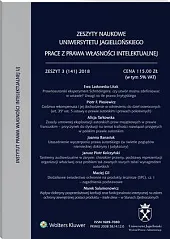Ewa Laskowska-Litak
p. 5
Piotr F. Piesiewicz
p. 32
Alicja Tarkowska
p. 47
Joanna Banasiuk
p. 70
Janusz Piotr Kolczyński
p. 86
Maciej Gil
p. 111
Marek Salamonowicz
p. 130
Ewa Laskowska-Litak
Schrödinger’s experiment in copyright law: Is a statutory defi nition of a ‘work’ possible? Remarks against the backcloth of UK law
The paper presents an analysis of the notion of work in the context of the United Kingdom’s statutory regulation: a system of closed catalogue of categories of copyright’s subject matter. Against this background, the paper’s aim is to ask about the consistency of the UK’s law with the current jurisprudence of the CJEU and with the advance of modern technologies. The fi rst part of the paper presents primary sources of the different regulation in the UK legal system and also the major myths and hypotheses about the UK law that are widespread in civil law countries’ literature. The second part focuses on a detailed analysis of the categories of subject matter in UK’s law, on the basis of case law and literature. The last part of the paper tests the initial hypotheses and aims to answer the question whether it is possible to provide a catalogue of categories of works in copyright law.
Back to top
Piotr F. Piesiewicz
‘Fair compensation’ and pursuing claims for payment of ‘fair compensation’ with reference to orphan works (Art. 358 (5) of the Copyright and Related Rights Act)
The pursuit of ‘fair compensation’ for using a work that has lost the status of an orphan work is a complex issue due to the way the claim is pursued. An analysis of the provisions of the Act of 4 February 1994 on Copyright and Related Rights clearly shows that the demand that ‘fair compensation’ be paid is a claim for payment of remuneration for using a work that had had the status of an orphan work and not a claim for damages. In determining the amount of such compensation, which is due to the copyright holder, all three criteria listed in article 358(5) of the Copyright and Related Rights Act have to be taken into account. These are the nature and scope of use of this work, the amount of revenue obtained on the basis of Art. 355(3), and the loss sustained by the rightholder. When calculating fair compensation, these three criteria must be considered together. There is no doubt that, on the one hand, a claim for the payment of ‘fair compensation’ is a civil law claim, and therefore it should be pursued in the civil procedure. On the other hand, an effective claim for payment is conditional upon prior fi nal decision issued in administrative proceeding. It means that the holder of copyrights in an orphan work, before obtaining ‘fair compensation’ for the use of his/her rights, must initiate administrative decision or the so-called tacit acknowledgement. Consequently, we should venture a statement that the exercise of rights by the holder of copyright in an orphan work, in accordance with Chapter 3 of the Copyright and Related Rights Act, requires as a rule the initiation of two separate procedures. The expiry of the status of an orphan work is indispensable for the rightholder to be able to demand ‘fair compensation’. In addition, it should be added that the holder of copyright in an orphan work acquires the locus standi in the civil proceedings for payment, enabling the exercise of the rig ht referred to in Art. 358(5) of the Copyright and Related Rights Act, only when the status of an orphan work expires. On the other hand, the capacity to act as a defendant in the particular civil proceedings applies to entities indicated in Art. 358 of the Copyright and Related Rights Act. They acquire the aforementioned capacity upon the grant of the rightholder’s request to delete the orphaned work from the database.
Back to top
Alicja Tarkowska
Principles governing contractual exploitation of author’s economic rights in French Law. A contribution in the discussion about the correctness of solutions adopted in the Polish copyright law
The article deals with the issue of agreements concerning the exploitation of author’s economic rights in French law, with particular emphasis on doubts arising from the application of such agreements and resulting from the way the regulation is structured, which is different from the solution adopted in the Polish law.
The authors and other actors of the copyright market in France, whose only option is an assignment agreement, which could lead, depending on the parties’ intention, to creation of either an obliging relationship, or an obliging-dispositive one, or even a dispositive relationship, face completely different legal problems than recipients of the Polish statute.
The lack of a statutory separation of a licence agreement in the French system does not mean that it is not commonly used in practice. But the conclusion of such an agreement and the determination of the effect that it will produce raises doubts justifying its regulation in the code, as postulated by legal scholars.
On the other hand, some Polish academics evaluate negatively the blurring of the boundaries between the licence agreement and the agreement transferring author’s economic rights, while trying to show that the lack of regulation of specifi c contracts is a signifi cant defi ciency of the Intellectual Property Code.
Bearing in mind the described difference and the proposals presented in literature, an explanation of the rules governing the assignment agreement and a comparison of solutions adopted in both legal systems are a very interesting starting point for comparative law considerations. Therefore, the purpose of the article is not only to analyse the legal character of the assignment agreement regulated in the French law and to indicate its fundamental elements, but also to try to evaluate solutions in the fi eld of exploitation of author’s economic rights.
Back to top
Joanna Banasiuk
Justifying copyright exhaustion (in the light of views expressed in German literature and case law)
The construction of copyright exhaustion aims at achieving a balance between the competing interests of the copyright holder and the buyer of a copy, while taking into account both the need to ensure free circulation of copies of works and the public interest in the circulation of knowledge and opinion. Full consideration of the above-mentioned interests in justifying the construction of exhaustion is possible with the cumulative understanding of theories explaining exhaustion, namely the theory of ownership, theory of confi dence (trust) in and safety of trade, theory of free movement of goods, and theory of remuneration. Taken jointly, they do not create a counterweight to protecting the interests of the copyright holder, but rather point to the necessity of resolving the confl ict and determining the moment when an intangible good is transformed into an economically viable product (copy of the work).
Back to top
Janusz Piotr Kolczyński
An outline of audiovisual royalties: legal character, grounds for representation by a relevant organisation, and the problem of the so-called old royalty tables
The Polish law introduced, in Art. 70(21) of the Act on Copyright and Related Rights, in addition to author’s economic rights, a separate legal right (to remuneration, which cannot be waived) with its particular type of protection, group of rightholders and scope, which in principle cannot be determined by an organisation for collective management of copyright and related rights, with the exception of using an approved royalty table. The author of this article tends to share the view about an inter-partes character of the right to the remuneration in question, rather than perceiving it as an element of an absolute author’s economic right. It would be an independent right, a legal norm that modifi es the contractual relationship between the producer (or the rightholders themselves) and the users of audiovisual works for the benefi t of the joint authors of audiovisual works or artistic performers. In this sense one can speak of an extended effect of the right to royalties. The author believes that since the statute refers to royalties as ‘equitable remuneration’, this draws attention to the contractual remuneration and the relationship between the righholder and the user, with the intermediary ‘in the background’, though acting as a party to the contract. In the author’s view, there more convincing arguments in support of the thesis that this relationship is one of indirect agency, which assumes the existence of a basic relationship between the collective management organisation and the rightholder in whose interest the CMO is to act, yet acting in its own name vis-à-vis the users, once the user (debtor) is required (mandatorily) to pay royalties to the rightholder (creditor) via the CMO. The author also believes that a CMO cannot, as a rule, determine the amounts of audiovisual royalties in abstract from it being entrusted with the rights under collective management. Yet this amount can result from an authoritative decision of the Copyright Commission approving a royalty table.
Finally, the author believes that – with the assumption of a rational legislator and considering the interpretation of provisions made by the Constitutional Tribunal – it can be accepted that the so-called old royalty tables approved on the basis of provisions repealed by the Constitutional Tribunal were reinstated in 2010 with effect for the future (ex nunc), which effect was made conditional upon the operation of a CMO, as can be demonstrated by the specifi c procedure of defi nitive loss of the aforementioned binding force by the old tables.
Back to top
Maciej Gil
Supplementary protection certifi cate for medicinal products (SPC) part I. Basic issues
The aim of the paper is to present the basic substantive principles governing the system of supplementary protection certifi cates for medicinal products (SPCs). In particular, the origin and ratio legis of the system, the catalogue of legal sources regulating the gra nting of SPCs, the basic concepts used in Regulation 469/2009, the prerequisites for obtaining SPCs, as well as the rules for determining the duration of SPCs are discussed.
The Court of Justice has played a generally positive role in resolving the questions raised by the application of Regulation 469/2009, the most problematic of which is the determination of the degree of specifi city of product description required in the claims of the basic patent. Although it is desirable to formulate a clear criterion in this respect, it will undoubtedly leave wide scope for interpretation and will not remove all uncertainty in this respect. However, it should not be suffi cient for the grant of an SPC for a combination of active ingredients to designate the second (or any subsequent) active ingredient of the combination only as a ‘different therapeutic ingredient’.
The second part of the paper will discuss issues related to the determining the scope of the protection resulting from the granting of SPCs, with particular emphasis on the analysis of the concept of a product.
Back to top
Marek Salamonowicz
The impact of post-sale confusion and aesthetic functionality doctrine on the scope of trade dress protection in the United States of America
The article discusses two judicial tests for the occurrence of the risk of confusion developed by U.S. courts the so-called: Polaroid and Sleekcraft tests. There is also a presentation of trend of expanding the protection of trade dress, which is visible both in the sphere of legislation (The Design Piracy Prohibition Act bill) and case law. Combating certain types of imitation, such as in Adidas v. Payless case, does not seem to have a strong foundation in the Lanham Act or the law of trademarks. It may lead to maintaining and strengthening the strong market position of the existing players by appropriating the aesthetic features of the product. Thus, such far- -reaching protection is debatable from the perspective of the foundations and assumptions of the system of intellectual property protection. Identifying products’ trade dress with the trademark often leads the courts to adopt an approach oriented towards protecting property rights to the trademark and the trade dress, and not an approach based on the misleading practice of taking over the external form of a product. The doctrine of aesthetic functionality formulated in case law is a manifestation of a different trend aimed at narrowing down the protection of the products’ trade dress. It clearly emphasizes the anchoring of products’ trade dress protection in the unfair competition law and combating the misleading of customers rather than combating imitation in general.
Back to top






